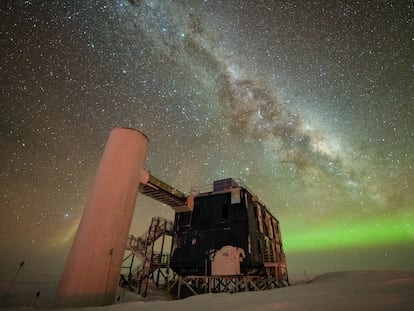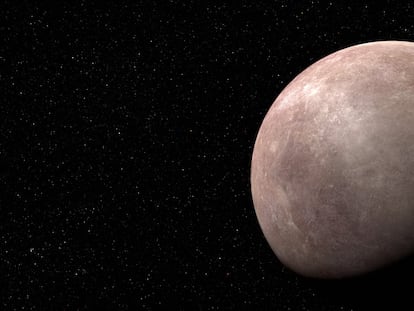Journey to the birthplace of the ELT, the largest optical telescope in the world: ‘It will be a revolution’
The monumental structure in the Chilean desert is the European Southern Observatory’s star project. Construction has passed the halfway mark and the device is on track to see its first light in 2028

In the middle of the driest desert in the world, 3,000 meters above sea level, the skeleton of a steel dome, as wide as the Colosseum in Rome and almost as tall as Big Ben, stands out against the reddish Atacama wasteland (in northern Chile). The structure being built on Mount Armazones will be the dome over the ELT (Extremely Large Telescope), which, as its name indicates, will be the largest telescope on the planet that is able to detect visible and infrared light. It is the flagship project of the European Southern Observatory (ESO) — an organization that brings together 16 countries from Europe, Australia as a strategic partner, and Chile as host — and it plans to see its first light in 2028.
“When the ELT begins operations, anything we find beyond [what has been observed up to now] will prove that everything we know is wrong,” German astronomer Elyar Sedaghati predicts from Paranal Hill, a remote Chilean location with a landscape more similar to Mars than Earth. ESO has already located the giant telescopes that make up the VLT (Very Large Telescope) there. The VLT is currently the largest optical-infrared observatory in the Southern Hemisphere and the second in the world, after Mauna Kea in Hawaii.
There is a tradition among astronomers at the Paranal Observatory of gathering to watch the sunset next to the VLT. The murmur of their conversations and the strong breeze hitting their windbreakers is the only thing that can be heard at the top of the mountain, more than 2,600 meters high and two hours by car from the nearest town. The sun sets over a blanket of thick, compact clouds that, tinted orange by the last rays, blend in with the sea. When the Pacific Ocean does appear clearly on the horizon, it means that the clouds are too high and will make it difficult to observe the universe at night.
The future plan of the European Southern Observatory is to complement the work of the VLT, in operation since 1999, and the ELT, which is halfway through its construction process. The strength of the former is provided by its four optical telescopes that each have an 8.2 meter diameter. The latter’s strength will largely come from its main mirror, measuring 39.3 meters in diameter and made up of 798 segments that are currently being manufactured in different European countries. “The observation capacity of this telescope must be thought of as when you are on the road and you see a car on the other side. From a distance, the two headlights look like a single point, but if you get close enough you can make out that there are two. How far away can you identify them? It depends on the size of the eye’s diameter. The diameter of the telescope is the same, they are eyes looking at the sky,” Italian astronomer Eleonora Sani explains. She was part of the team that made observations of the first kilonova, the most important discovery of 2017, according to the scientific journal Science.
To put into perspective what the ELT will be able to do, Spanish astrophysicist Juan Carlos Muñoz compares it to the very powerful James Webb Space Telescope (JWST): “The ELT is going to have a diameter about six times larger and a light-collecting capacity almost 30 times greater, which will allow us to see even the first galaxies from the dawn of the universe in greater detail.” He also anticipates that it will open the door to finding out if the Milky Way’s black hole rotates and, if so, at what speed. “For that we need to see very faint stars that pass very close to the black hole. By combining the VLT tools with those that the ELT will have, we will be able to map the orbits of those stars in three dimensions to find out,” he says. “It will be a revolution. Not just a step [for mankind], it will be a leap,” adds an enthusiastic Sani.
What do you hope to find? Elyar Sedaghati, whose field of research is the atmosphere of exoplanets, remarks that current data is too limited to develop theories about them. “I have the feeling that when we start observing them with the ELT we are going to realize that our theories, which basically work with one-dimensional models, are completely inadequate and that we have to start developing three-dimensional models, that incorporate climate theory,” he says. He hopes that the future most powerful telescope on Earth will help explain how the atmospheres of other worlds can exist, and how they circulate. Taking it to a more general level, Sedaghati adds: “We are actually very ignorant about how galaxies have evolved over billions of years.”
The construction of the ELT began in 2017 and by mid-2023, 50% of the megaproject had been completed. The construction managers explain that the first half took a long time because it involves many prototypes and tests, in addition to the stoppage due to the pandemic, but that the second phase “should be much, much shorter.” The 798 segments that will make up the majority of the telescope’s five mirrors, as well as other parts of the optical instrument, are being manufactured in different countries in Europe and will begin to arrive in Chile in the first half of 2024. The German Tobias Müller, director of ELT assembly, integration, and verification projects, estimates that it will take one day for each of the hundreds of mirror segments that arrive, which must be cleaned and have mechanical components such as sensors and cables installed: “This has never been done. It is a process that could be the beginning of an industry.”
The dry environment and high altitude of the Atacama Desert, together with the lack of light pollution and a sky that is clear 300 days a year, are the perfect cocktail for observing the cold universe, which is invisible to conventional telescopes. And it also offers a clear spectacle to the naked eye of anyone curious enough to observe the night sky.
Once the sun sets and the Andes and the Pacific disappear into darkness, you find yourself surrounded by several million stars. Look in any direction and you’ll see them. Against this backdrop, you don’t have to be on the lookout for shooting stars: they appear continually. The small and large Magellanic clouds can be seen in detail. The two dwarf galaxies orbit the Milky Way like satellites, taking at least one billion years to complete their circuit. The constellation of Orion also stands out, and so does the red supergiant Betelgeuse, a star much larger than the Sun and which is almost at the end of its life.
The Milky Way, which is invisible from many locations due to light pollution, shines over the Paranal observatory. Only the lasers beaming out from one of the VLT’s telescopes interrupt the starry panorama. Using these instruments, scientists confirmed that there is a supermassive black hole at the center of our galaxy, in research that received the Nobel Prize in Physics in 2020. From that same enclosure it is impossible to see the gigantic skeleton of the 6,000-ton dome of the ELT, located just 20 kilometers away. However, astronomers, who are accustomed to the thrill produced by what is imperceptible to the eye, say they are waiting with hope because they know it is there.
Sign up for our weekly newsletter to get more English-language news coverage from EL PAÍS USA Edition
Tu suscripción se está usando en otro dispositivo
¿Quieres añadir otro usuario a tu suscripción?
Si continúas leyendo en este dispositivo, no se podrá leer en el otro.
FlechaTu suscripción se está usando en otro dispositivo y solo puedes acceder a EL PAÍS desde un dispositivo a la vez.
Si quieres compartir tu cuenta, cambia tu suscripción a la modalidad Premium, así podrás añadir otro usuario. Cada uno accederá con su propia cuenta de email, lo que os permitirá personalizar vuestra experiencia en EL PAÍS.
¿Tienes una suscripción de empresa? Accede aquí para contratar más cuentas.
En el caso de no saber quién está usando tu cuenta, te recomendamos cambiar tu contraseña aquí.
Si decides continuar compartiendo tu cuenta, este mensaje se mostrará en tu dispositivo y en el de la otra persona que está usando tu cuenta de forma indefinida, afectando a tu experiencia de lectura. Puedes consultar aquí los términos y condiciones de la suscripción digital.
More information
Archived In
Últimas noticias
Daytime, headphones, no booze involved: How a generation is saying ‘no’ to club parties
Millennia-old Yuracaré language resists extinction through 900 speakers and a new dictionary
Susan Boyle prepares a comeback just as Timothée Chalamet sings her praises
Trump suspends green card visa lottery after shooting at Brown University
Most viewed
- Christian Louboutin: ‘Young people don’t want to be like their parents. And if their parents wear sneakers, they’re going to look for something else’
- Cartels in Mexico take a leap forward with narco-drones: ‘It is criminal groups that are leading the innovation race’
- Liset Menéndez de la Prida, neuroscientist: ‘It’s not normal to constantly seek pleasure; it’s important to be bored, to be calm’
- ‘El Limones’ and the growing union disguise of Mexican organized crime
- The low-cost creative revolution: How technology is making art accessible to everyone











































